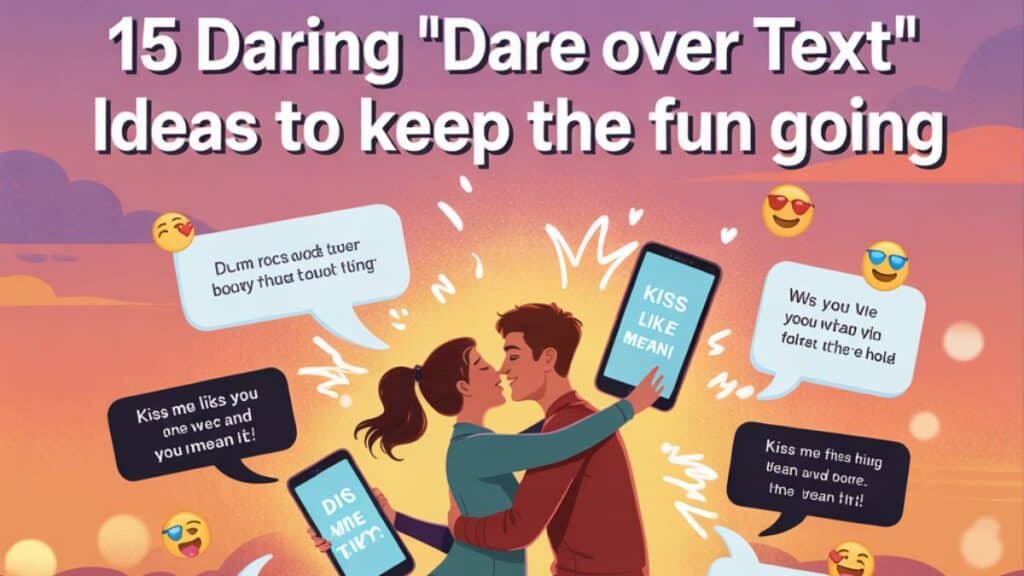Dare Over Text refers to the playful act of sending dares through text messages, often used as a lighthearted and fun way to engage with friends, crushes, or partners. These dares can range from silly and humorous tasks to flirtatious or even slightly bold challenges, all designed to keep conversations entertaining and emotionally engaging.
In the digital age of quick chats and emojis, Dare Over Text has become the ultimate way to keep things exciting. It breaks away from boring small talk and invites spontaneity, laughter, and a hint of mystery into everyday conversations. It’s not just texting — it’s a game, a flirt, and a spark rolled into one.
Whether you’re looking to deepen a bond, ignite a new connection, or simply have fun, Dare Over Text offers endless possibilities. From funny challenges to romantic confessions, this texting trend is perfect for anyone who craves a little adventure in their digital life.
The Science Behind Text-Based Dares
The psychology of texting challenges runs deeper than you might think. When we communicate through screens, our brains process social cues differently. The absence of immediate visual feedback reduces anxiety while increasing our willingness to take risks.
Conversation starters that involve dares tap into our natural desire for excitement and novelty. The brain releases dopamine when we anticipate something thrilling – and that’s exactly what happens when someone sends you a dare over text.
Research shows that shared risk-taking builds stronger bonds between people. When you and your crush exchange playful dares, you’re creating a shared experience that goes beyond typical small talk. The mystery of not knowing what challenge comes next keeps both parties engaged and invested.
Messaging ideas that incorporate dares also trigger the psychological principle of reciprocity. When someone accepts your dare, they’re more likely to dare you back. This creates a positive feedback loop that can keep engaging messages flowing for hours.
Essential Ground Rules Before You Start
Before diving into fun dares, establish clear boundaries. Consent isn’t just important – it’s everything. Never send a dare that makes someone uncomfortable or pressures them into revealing personal information they’re not ready to share.
Create a safe word system for your texting game sessions. Something simple like “pause” or “skip” signals that someone wants to move to a different dare without ending the fun entirely. This builds trust and ensures everyone stays comfortable.
Privacy concerns matter enormously with texting dares. Assume anything you send could potentially be screenshotted. Only share content you’d be comfortable with others seeing. This applies especially to selfie dares or confession dares that reveal personal details.
| Boundary Type | Example | Why It Matters |
|---|---|---|
| Emotional | No dares about past relationships | Protects mental health |
| Physical | No requests for inappropriate photos | Maintains dignity and safety |
| Social | No public embarrassment dares | Preserves reputation |
| Time-based | Respect work hours and sleep | Shows consideration |
Pay attention to response times and enthusiasm levels. If someone takes forever to respond or gives short answers, they might not be feeling the dare ideas you’re suggesting. Reading the room applies to digital spaces too.
Flirty & Playful Dares
Send a Photo of Your Weirdest Talent
This dare over text breaks the ice without crossing personal boundaries. Everyone has some quirky skill – whether it’s touching their nose with their tongue or balancing a spoon on their nose. It’s funny, harmless, and reveals personality.
The beauty of talent show dares lies in their unexpectedness. You might discover your crush can juggle or that your friend does amazing voice impressions. These moments create genuine connection and often lead to longer conversations about hobbies and interests.
Text Using Only Song Lyrics for an Hour

Creative texting challenges push people out of their comfort zones. This dare transforms ordinary conversations into artistic expressions. You’ll be amazed how creative people become when forced to communicate through existing song lyrics.
This texting challenge works particularly well with romantic interests because song lyrics naturally lean toward emotional expression. Someone might accidentally reveal their feelings while trying to ask about dinner plans through Taylor Swift lyrics.
Share Your Most Embarrassing Autocorrect Fail
Humor builds connections faster than almost anything else. Everyone has autocorrect horror stories, and sharing them creates instant relatability. This dare works because it’s safe – the embarrassment already happened, so there’s no new risk involved.
The key to successful funny dares is ensuring they’re self-deprecating rather than embarrassing to others. You want people laughing with you, not at you. Autocorrect fails hit that sweet spot perfectly.
Send a Voice Message in Your Best Fake Accent
Voice message dares add a personal touch to digital communication. Hearing someone’s voice creates intimacy that pure text can’t match. Adding the element of a fake accent makes it playful rather than serious.
This challenge works because it’s temporary and silly. Nobody expects Oscar-worthy performances. The goal is entertainment and bonding through shared laughter. British accents tend to be crowd-pleasers, but encourage creativity.
Post a Story with the Most Unflattering Angle Possible
Social media dares that involve intentionally unflattering content flip the script on curated online personas. This dare builds attraction through authenticity and confidence. Someone willing to look silly for a laugh demonstrates secure self-esteem.
The 24-hour nature of stories makes this dare feel safe – the content disappears automatically. This temporary aspect encourages participation from people who might otherwise hesitate.
Bold & Adventurous Dares
Order Food Using Only Emojis
Emoji dares combine creativity with real-world application. This challenge tests communication skills while potentially providing entertainment for restaurant staff. The key is choosing a place that accepts online orders through apps that support emoji communication.
Document the entire process with screenshots. The funny miscommunications that result often become inside jokes. One person might order pizza 🍕 but receive pasta 🍝 – these mixups create memorable stories.
Start a Conversation with a Stranger About Their Pet
This dare over text requires real-world action but reports back through messages. It builds confidence while creating positive interactions with others. Most pet owners love talking about their animals, making this a relatively safe social challenge.
The texting component comes from sharing the story afterward. Did the stranger show 47 photos of their cat? Did you learn about their dog’s favorite toy? These details make for engaging messages that continue the dare experience.
Send a 30-Second Video of You Attempting a New Dance Move
Video dares push comfort zones while staying playful. Dancing requires vulnerability – you’re putting your body and movement on display. But the amateur nature of “attempting” removes pressure for perfection.
TikTok has normalized dancing videos, making this dare feel less intimidating than it might have five years ago. Choose trending dances or create your own. The entertainment value comes from effort, not expertise.
Text Your Ex a Completely Random Question (Harmless Only)
This bold dare requires careful consideration. The question must be genuinely random and completely harmless – think “Do you remember the name of that restaurant with the weird pickle mascot?” rather than anything relationship-related.
The thrill comes from the unexpected contact without reopening old wounds. Sometimes these interactions lead to funny responses that become great stories. However, skip this dare if there’s any chance of causing emotional harm.
Change Your Profile Picture to Something Completely Unexpected
Social media dares that involve profile changes create temporary mystery among your broader social circle. Choose something completely different from your usual style – a childhood photo, a random object, or a funny filter.
The excitement builds as friends notice and comment. This dare works because it’s visible to everyone but harmless. The temporary nature (24 hours maximum) makes it feel safe while still being adventurous.
Intimate & Vulnerable Dares
Share Your Biggest Irrational Fear
Confession dares that reveal personal details build deep connection between people. Everyone has fears that don’t make logical sense – spiders, clowns, or butterflies. Sharing these creates intimacy through vulnerability.
The “irrational” qualifier makes this dare feel safer. You’re not revealing trauma or serious anxieties – just quirky fears that might make someone laugh while bringing you closer together.
Send a Photo of Your Messiest Room Right Now
Selfie dares that show imperfection counter social media’s highlight reel culture. This challenge builds trust by revealing the real, unfiltered version of your living space. It’s intimate without being inappropriate.
The “right now” aspect prevents cleaning or staging. You’re sharing your authentic moment, messy dishes and all. This vulnerability often leads to deeper conversations about life, stress, and authenticity.
Confess Something You’ve Never Told Anyone
This represents the peak of texting dares in terms of emotional risk. Choose something meaningful but not traumatic – perhaps a childhood dream, a secret talent, or an unusual preference. The goal is connection, not therapy.
Romantic partners often find these revelations particularly bonding. Learning something completely new about someone you’re close to creates a special moment of discovery and trust.
Send a Voice Note Singing Your Favorite Childhood Song
Singing dares combine vulnerability with nostalgia. Childhood songs carry emotional weight and memories. Sharing them through voice notes creates intimacy through both the singing and the song choice.
Don’t worry about vocal quality – the charm lies in the willingness to be vulnerable. These voice messages often become saved favorites that people revisit when they need to smile.
Share the Last Thing That Made You Cry (Happy or Sad)
Emotional dares like this one require significant trust between participants. They work best with close friends or romantic interests who’ve already established emotional safety. The tears could be from joy, sadness, or even laughter.
This dare often leads to meaningful conversations about emotional expression and life experiences. It’s a gateway to deeper connection and understanding between people.
Advanced Dare Strategies

Dare chains build momentum by connecting multiple challenges. Start with lighter playful dares and gradually increase intensity. Each completed dare builds confidence for the next one. This progression keeps participants engaged while respecting comfort levels.
Time limits add urgency and excitement to challenges. “You have 10 minutes to…” creates immediate pressure that can be thrilling. However, balance urgency with safety – never rush someone into something they’re not ready for.
The reverse dare technique involves letting the other person choose your challenge from a list of options. This gives them control while ensuring you’re comfortable with all possibilities. It’s particularly effective for long-distance couples who want to feel more connected.
Ongoing dare relationships develop their own culture and inside jokes. Regular texting game partners often create personal traditions, callback references, and escalating challenge levels. These relationships can span months or years, creating deep bonds through shared adventure.
Digital Dare Etiquette
Respecting boundaries means accepting “no” immediately and gracefully. Never pressure someone to complete a dare they’re uncomfortable with. A simple “no worries, how about this instead?” maintains the fun while showing respect.
The 24-hour rule suggests deleting evidence of dares after a day unless specifically agreed otherwise. This applies to photos, videos, and screenshots. It builds trust and encourages participation by ensuring temporary embarrassment stays temporary.
Professional considerations matter enormously. Never dare someone to do something that could affect their job, reputation, or relationships with family. The digital age means content can resurface unexpectedly, so err on the side of caution.
| Age Group | Appropriate Dare Level | Avoid |
|---|---|---|
| Teens (13-17) | Light, funny, school-safe | Anything romantic or risky |
| Young Adults (18-25) | Flirty, adventurous, social | Professionally damaging content |
| Adults (25+) | Full range with consent | Family-inappropriate content |
Troubleshooting Common Dare Disasters
When dares go too far, immediate damage control involves sincere apologies and concrete action. Delete any problematic content, apologize specifically for the boundary crossing, and give the person space to process. Don’t minimize their feelings or make excuses.
Screenshot betrayal represents one of the biggest trust violations in digital dares. If someone shares your dare responses without permission, address it directly. Set clear expectations about privacy from the beginning to prevent these situations.
Dare anxiety affects people differently. Some thrive on challenge while others feel overwhelmed. Watch for signs like delayed responses, shortened answers, or requests to stop. The graceful exit strategy involves suggesting a break while leaving the door open for future fun.
Pressure management requires reading subtle cues in digital communication. If someone seems hesitant, offer easier alternatives or switch to regular conversation. The goal is entertainment and connection, not stress or discomfort.
Beyond Basic Texting: Platform-Specific Dares

Instagram story dares leverage the platform’s 24-hour disappearing feature. These challenges work well for social media content that’s meant to be temporary. The broader audience adds excitement while the automatic deletion provides safety.
Snapchat challenges use the app’s built-in timer feature to create urgency. The screenshot notifications add an extra layer of trust verification. These dares often involve quick, spontaneous content that captures authentic moments.
TikTok micro-dares tap into the platform’s short-form video culture. These challenges often go viral, creating the possibility of broader entertainment beyond just the two people involved. However, consider privacy implications before posting dare content publicly.
Discord server group dares work well for friend groups who want to participate in challenges together. The real-time chat feature allows for immediate reactions and follow-up conversation starters. Group dynamics can amplify both fun and pressure, so moderation is key.
The Psychology of Why We Dare
Adrenaline addiction in digital spaces provides safe thrills without physical danger. Texting dares trigger the same biological responses as real-world risks but with controlled outcomes. This makes them particularly appealing to people who crave excitement but avoid genuine danger.
Confidence building through controlled risk helps people expand their comfort zones gradually. Successfully completing challenges creates positive reinforcement that encourages future risk-taking. This psychological benefit extends beyond digital spaces into real-world confidence.
Shared secrets create powerful bonds between people. When someone trusts you enough to complete a vulnerable dare, they’re essentially sharing a piece of themselves. This intimacy through vulnerability forms the foundation of deep relationships.
Personality revelation through dare responses provides insights that normal conversation might not reveal. How someone approaches challenges, their humor style, and their risk tolerance all become apparent through their dare participation.
Creating Your Own Dare Culture
Dare traditions with friends can become defining features of relationships. Maybe you always start Friday nights with texting games, or perhaps you have seasonal challenges that mark holidays and special occasions. These traditions create anticipation and bonding opportunities.
Group dynamics in dare communities require careful moderation. Peer pressure can push people beyond their comfort zones in unhealthy ways. Establish group rules that prioritize consent and safety while maintaining fun and excitement.
Accountability systems help ensure dares actually get completed. Some groups use honor systems while others require photographic evidence. The key is matching the accountability level to the trust and comfort within the group.
Personal dare journals track your growth and memorable moments. Record particularly funny or meaningful challenges, note how your confidence has grown, and identify patterns in what types of dares you enjoy most.
Your Next Move

Which dare will you try first? Start with something that feels exciting but not overwhelming. Flirty dares work well for new romantic interests, while funny challenges suit friendships and group dynamics.
Finding the right person to dare involves considering your relationship level and their personality. Adventurous people might appreciate bold challenges, while sensitive individuals might prefer gentle or creative options.
Starting small builds confidence for both participants. Begin with light-hearted challenges that establish trust and comfort before progressing to more vulnerable or intimate dares.
Create your personal dare journal to track favorite challenges, memorable responses, and relationship developments. This record becomes a treasure trove of inside jokes and bonding moments that strengthen your connections over time.
The world of texting dares offers endless possibilities for connection, entertainment, and personal growth. Whether you’re looking to flirt with a crush, bond with friends, or spice up a long-distance relationship, these challenges provide safe ways to take risks and create memories together.
Remember that the best dares prioritize fun and connection over shock value or boundary pushing. When everyone feels safe and respected, the magic of shared adventure can truly flourish through your screens.
conclusion:
Dare Over Text is a fun and simple way to make your chats more exciting. It helps people laugh, connect, and feel closer, even when they are far apart. Whether you’re talking to a friend, crush, or partner, a playful dare can make the moment more special.
Adding Dare Over Text to your conversations keeps things fresh and interesting. It’s a great way to show your fun side and learn more about the other person. Try it today and see how one small message can create big smiles.
FAQs:
What is a “Dare Over Text”?
A Dare Over Text is a playful message challenge you send via text to spark fun, laughter, or flirtation.
Why use a Dare Over Text?
It adds excitement, breaks routine communication, and helps you bond or flirt in a casual way.
Who is it best for?
It works great with friends, crushes, partners, or even long-distance connections wanting light-hearted fun.
Any tips for safe dares?
Keep dares respectful, lighthearted, and within comfort zones—never pressure anyone to share private info.
How often should I do it?
Use it sparingly—once in a while adds surprise and excitement; overdoing it might feel forced.

Abdul Matloob is a wordsmith with a sharp eye for grammar and a playful love for puns. Blending linguistic precision with clever humor, he crafts content that delights language lovers and grammar geeks alike. Whether he’s breaking down the quirks of English grammar or delivering punchy puns that make readers groan and grin, Abdul Matloob turns language into both an art and a game.







